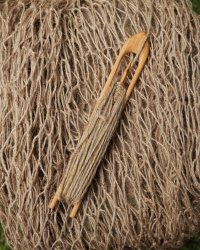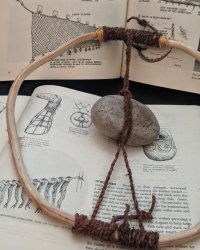Continuing on from my net project I have been making some gill net sinkers.

Willow cordage, cedar roots binding and cedar withie (untwisted) dried into a hoop to suspend a stone weight.
-Books used for reference-
Cedar: Tree of Life to the Northwest Coast Indians
Indian Fishing: Early Methods on the Northwest
both books by - Hillary Stewart

This was my first attempt but I have made 3 for the net.
I love these books and always find myself drawn to them for inspiration, highly recommended to add to your bookshelf if you don't yet own them.
Tim

Willow cordage, cedar roots binding and cedar withie (untwisted) dried into a hoop to suspend a stone weight.
-Books used for reference-
Cedar: Tree of Life to the Northwest Coast Indians
Indian Fishing: Early Methods on the Northwest
both books by - Hillary Stewart

This was my first attempt but I have made 3 for the net.
I love these books and always find myself drawn to them for inspiration, highly recommended to add to your bookshelf if you don't yet own them.
Tim

 We wanna see em!
We wanna see em!